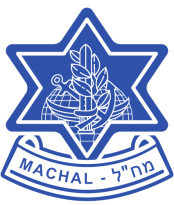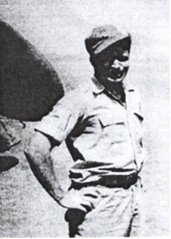
(Photo: South Africa’s 800)
Sydney Cohen was born and grew up in the small rural village of Bothaville in the Orange Free State in South Africa. Afrikaans was his main language as a youngster; he even wrote his matriculation examination in that language. He was in his first year at medical school when World War II broke out. He left his studies, volunteered for the military and was accepted into the South African Air Force’s flight school. Completing pilot’s training, in early 1942, he was assigned to fly fighters with No. 4 Squadron flying American-built Curtiss Kittyhawk planes.
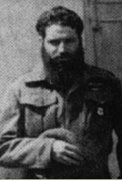
Syd Cohen in No. 4 Squadron, South African Air Force
(Photo: 101squadron.com)
Eventually the squadron switched to Spitfires. Jack Cohen and Lionel Bloch (fellow Machalniks) would later join No. 4 Squadron. While No. 4 Squadron was still active in North Africa, Syd’s tour of duty expired, but he signed up for a second time and was posted to No. 11 Squadron of the SAAF, and served in Italy. Sydney Cohen visited Palestine twice while he was serving in No. 4 Squadron in the Middle East. “I got a taste for it,” he said. Syd was affectionately called “The Flying Rabbi of World War II” because of his beard. During World War II, he also won the “Mentioned in Dispatches” award.
In April 1948, even though he was then a third-year medical student making up for the lost years of World War II, he sought out Yoel Palgi, the Haganah recruiter in South Africa, and volunteered to fight in Israel’s War of Independence. Yoel Palgi snatched him up. Cohen volunteered together with two other ex-SAAF pilots, Issy Noach and Les Shagam. All three left Palmietfontein on a flight together with other volunteers at the end of May 1948.
These three pilots were sent to Geneva, where Cohen and Shagam were advised they would be leaving the next day for Czechoslovakia to learn to fly Messerschmitts (ME109). On 23rd April 1948, the Haganah had made a deal with the Czechs for 10 Messerschmitts, with an option for another 15, and Czechs would coach Machal pilots in flying the planes, as well as dispatching Czech mechanics to Israel to assemble them.
Syd Cohen and Les Shagam were transported with two American Jewish pilots to Ceske Budejovice, where they joined a handful of other pilots. This second group included Boris Senior.
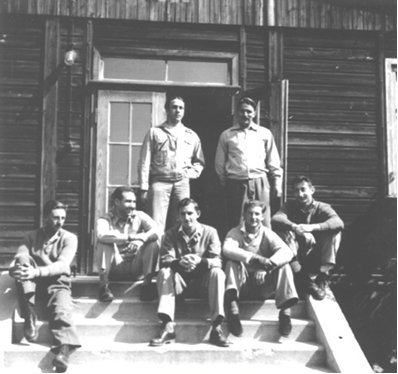
Ceske Budejovice, June 1948
Standing left to right: Chris McGee and Syd Cohen
Lower row left to right: Boris Senior, George Lichter, Les Shagam,
Arnie Ruch, Rudi Augarten
(Photo: 101squadron.com)
At the end of the course the men threw a party for their instructors, spent a few days in Zatec and Prague, and then boarded an Israeli Skymaster carrying equipment and light arms. They arrived at Ekron (Akir) on the eve of the first truce which began on 11th June, 1948.
Syd had flown together with Arnie Ruch and within a day they were at the fighter squadron’s airstrip in Herzlia. They were joined by Lionel Bloch and two U.S. pilots, Syd Antin and Aaron (Red) Finkel. Thus, in the final days of the first truce, Israel had an assembly of about fifteen Messerschmitts and a group of fighter pilots – Americans George Lichter, Rudy Augarten, and South Africans Arnold Ruch, Lionel Bloch, and Les Shagam.
Jack Cohen was to arrive in August and Les Shagam would soon transfer to operations. There were three Israelis – Modi Allon, Ezer Weizman and Sandy Jacobs – and two ex-RAF pilots, Maurice Mann and Leo Nomis.
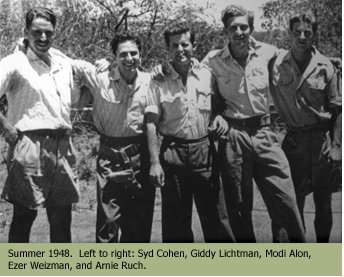
(Photo: 101squadron.com)
”Everything I know, I learned from Syd Cohen,” said the ever-ebullient Ezer Weizman, later Commanding Officer of the IAF, and much later President of the State of Israel. Whenever Weizman spoke of Syd Cohen, his respect for him was unmistakable.
Leo Nomis was a non-Jewish American Machalnik who had flown with the Royal Air Force in World War II. Leo stated in his memoirs that he had known Syd Cohen in 1942 when he was in 92 Squadron RAF; they had met at a party in the Western desert. “We drove up to the mess tent of the South Africans, who always had brandy, and it was the first time I met Syd. Six-foot-two inches in height, he was standing at the tent flap with tin cups in his hands and he ordered us to have a drink. He called himself “Cohen the Jew,” and he led everyone in singing ribald songs. We stayed there all night. Now we stand in the dust beside a stone hut in Israel. The beard is gone, but there is the same flat nose, the wide face, the calm eyes. Syd’s unmatched qualities as a pilot and a leader precipitated his immediate appointment as a 101 Squadron Flight Commander on the flight from Czechoslovakia. To Syd, the fact that we were flying Messerschmitts seemed forever ironic and comical.” [The irony of Jews fighting for their lives with the dreaded German plane of World War II.]
Nomis was assigned to Cohen’s B flight and recalls one preflight briefing:
“Syd Cohen arranged for me to go on a four-plane sector patrol. Giddy Lichtman is appointed to lead the formation and the others are Ezer Weizman and Sandy Jacobs. When we go back outside, Syd unfolds a map on the ground. He points to the salient created by the Partition, and indicating that Tul-Karm is the apex, he moves his finger along the approximate positions of the Arab lines. He looks at Giddy and says that we will stay away from them today.”
Nomis, who shared a tent with Cohen and Ruch at Herzlia, comments on the conversations of the two South Africans. They often spoke in Afrikaans, and the good-natured Arnie laughed at everything Syd said.
The first Spitfire, designated D-130, was configured as a photo-reconnaissance machine. Only experienced Spitfire pilots were allowed to fly it. At first the list was limited to Modi Alon, Syd Cohen, Maury Mann, Arnie Ruch, and Boris Senior, and as soon as he arrived, Leo Nomis, But as more volunteers showed up, particularly Canadians, the number of pilots eligible to fly it increased. The aircraft’s first 101 Squadron flight, a shakedown, took place on 5th August with Syd Cohen at the controls. Boris Senior was the one who dared to test-fly the Spitfire, built from parts found at former British airfields.
During the visit by Prime Minister David Ben-Gurion to Herzlia air strip on 17th August, Modi Alon scrambled Syd Cohen and four of his B flight pilots, if only to show off in front of the prime minister. Leo Nomis recalled the event: “Everyone is milling about when a suspicious aircraft appears high overhead, a tiny speck against the wisps of cirrus clouds streaked across the deep blue above. The patrol aircraft had landed before the Rapide came in and everyone just looks upward and watches the intruder plane.
“B Flight is on standby and Syd Cohen looks over at Modi to see what he is going to do. Ben-Gurion is also looking at the sky, shading his eyes with his hand. Abruptly, Modi tells Cohen to scramble four planes. Cohen points to me, grabs Giddy Lichtman by the arm, and shouts to Bill Pomerantz.
“We start running to the nearby jeep and we jump in. Cohen floors the throttle pedal when the motor starts. We head for the revetments. The rotund Pomerantz smiles skeptically as we watch the suspicious plane fast disappearing to the north. Everyone knows it is futile to scramble and when we get to the standby Messerschmitts, Modi cancels it. A red flare arches up from behind the Ops tent and falls to earth out on the field, where it burns and splutters for a moment. The gesture for the prime minister has been made. An hour later Ben-Gurion leaves and the Rapide lifts off slowly in the midday sun.”
In late August, walking back to their tent at Kfar Shmaryahu, Syd Cohen said to Leo Nomis that if he survived the war, and if in the end the Jews are guaranteed their national homeland, he is going back to Johannesburg to complete his medical degree.
The next day 101 Squadron returned to Herzlia. Cohen took D-130 out to snap some pictures of Gaza. Leo Nomis, returning from a patrol in an S-199, met him by chance: “When I came out of the Ops tent, Syd Cohen was going by in a jeep with Croll (the squadron ops officer). They stop, and I ride out to the Spitfire dispersal point with them. Syd is going on a PR flight to Gaza, and as he puts on his gear I tell him about the suspicious aircraft episode. He laughs and goes over and looks at the map which Croll seems eternally to have in his hand. A Messerschmitt is taking off and we can’t hear anything for a minute. Syd wipes his mouth with his forearm. When he gets up on the wing of the Spitfire, Croll extends a revolver in a fabric holster toward him. He tells Croll he doesn’t want it. He says they are too bulky to wear in the cockpit and that they are too dangerous to be carrying if you are captured. Croll agrees, but says it is an order from headquarters that the reconnaissance pilots must wear a sidearm. Syd still doesn’t want it. Croll looks at the ground beside the wing for a moment. He says it’s not necessarily for use against the enemy. He says it’s for Syd’s use on himself if he is captured by irregulars. The statement amuses Syd. He takes the gun and straps it on and climbs into the cockpit.”
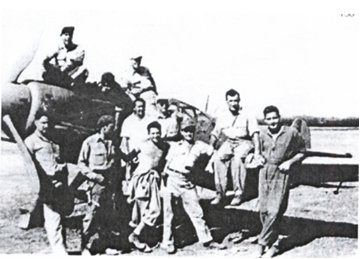
Pilots of 101 Squadron – approx. July 1948
Top row, left to right: Maury Mann, Ezer Weizman, Red Finkel
Middle row: Bill Pomerantz, Sandy Jacobs
Bottom row: Syd Cohen, Chris McGree, Giddy Lichtman, Leon Frankel,
Syd Antin (seated) and Leo Nomis
(Photo: Syd Cohen)
Syd was later referred to in all conversations as being “special.” When he took over as 101 Squadron’s Commanding Officer, Syd Antin, like many others, was impressed with his leadership qualities.
Syd Cohen was to do more flying than any other pilot of 101 Squadron. This was his log book for the period:
| June 21, 1948 | ME-109 | Test and Ferry |
| June 23 | Auster | Les Shagam, passenger, general flying |
| June 24 | Auster | Passengers, general flying |
| June 25 | ME-109 | Bombing and strafing mission |
| June 27 | ME-109 | Formation flying |
| June 30 | ME-109 | Patrol over Faluja |
Syd Cohen made fourteen flights in August – patrol training in close support, test flights in ME-109s, and photo reconnaissance. In mid-September, Arab flak had begun to fire at the Israelis in earnest, and on one trip to Gaza, the bursts chased Cohen out over the Mediterranean.
On 22nd September 1948 Syd Cohen, together with three other South African fighter pilots – Boris Senior, Arnie Ruch, and Tuxie Blau – together with Modi Alon, were flown out of Israel to Yugoslavia and then to Czechoslovakia, to bring the first covey of six of the 50 purchased Spitfires back to Israel. On the morning of 24th September, six Velvetta I Spitfires left Kunovice, Czechoslovakia for Niksic, Yugoslavia, 300 miles away, with Modi Alon, Boris Senor, Syd Cohen, and Tuxie Blau joining Sam Pomerance and Jack Cohen behind the controls. Boris Senior had opted to give the last pilot slot to Tuxie Blau over Arnie Ruch, although Ruch had more experience. Ruch traveled in the C-54 that led the group. Of the seven available fighter pilots, all but Alon and Pomerance hailed from South Africa. Without built-in radios, the pilots communicated as well as they could, albeit poorly, with walkie-talkies. Blau forgot to lower his landing gear at Niksic and damaged his plane, but was unhurt. The remaining five Spitfires led by the C-54 mother-ship took off for Israel three days later. In the end, only three reached Ramat David airbase. Because of fuel tank problems, Boris Senior and Modi Alon had to force-land on the Greek island of Rhodes, where they were arrested and jailed for two weeks.
On 16th October, Syd together with Maury Mann, a Battle of Britain veteran, was just about to take off in two of the Spitfires, when he unfortunately witnessed Modi Alon’s fatal accident when his plane nose-dived into the ground. Modi Alon, Commanding Officer of 101 Squadron, had been returning with Ezer Weizman from a two-Messerschmitt mission against the retreating Egyptians near Ashdod. Syd Cohen was chosen to replace Modi as Commanding Officer of 101 Squadron, and he accepted the post with sadness. Syd, with his leadership qualities, became the one to shape the future of Israel’s fighter squadron after Alon’s death. Syd Antin, American fighter pilot, had this to say: “Syd Cohen was a great guy. Everybody loved him. He had a great deal of wisdom for his age, and experience, and people respected that.”
During “Operation Yoav,” which began on 15th October, Syd Cohen, Jack Cohen, and Rudy Augarten set off in three Spitfires, hooked up with two Beaufighters, to attack El Arish at 4 p.m. with the objective of putting the airfield and its planes out of action. The Beaufighters dropped their bombs, and the Spitfires strafed everything they could see. The aircraft in the hangars called for some low flying by the three veterans, who were equal to all that was required of them.
The Negev was aflame. There was no delay in following-up on the Spitfire attack. Strafing Beaufighters came in, swooping low over the hangars, the Fortresses following. Stores were set ablaze and the runway pitted with craters.
Syd Cohen’s log book with its record of missions almost every day during the fighting periods, reflect the quieter days of cease-fire in November:
| November 1, 1948 | Spitfire | Patrol, Gaza-El Arish |
| November 3 | Spitfire | Patrol, El Arish-Gaza-Faluja |
| November 4 | Mustang P51 | Bomber escort, Faluja |
| November 13 | Mustang P51 | Patrol, Faluja-El Arish |
| November 18 | Spitfire | Escort to Photo Reconnaissance |
| November 26 | Mustang P51 | Patrol, Faluja-El Arish |
| November 29 | ME-109 | Test Flight Reconnaissance, Hebron |
On November 2nd, an intruder was detected by the makeshift Israel Radar developed with few resources by Squadron 505. This mobile station was commanded by South African Maurice Ostroff. A single reconnaissance plan had flown high almost daily over Israel. Syd Cohen left standing instructions with Ramat David to keep him immediately informed of its observations.
An American non-Jewish pilot, Wayne Peake, went up in a Mustang to intercept the intruder. Syd Cohen, standing in the control tower at Hatzor, guided Peake right to it. Peake opened up with the limited Mustang ammunition. The reconnaissance plan continued its flight. The Mustang broke away to come down. Suddenly Cohen noticed that the vapor trails of the intruder were getting thicker. It turned towards the sea, burst into flames in mid-air and fell out of the sky in pieces. When the Israel Navy retrieved the wreckage, it was identified as an RAF Mosquito.
The swiftness of the Israeli drive during “Operation Horev” is best conveyed by this story from Syd Cohen: “I flew out alone on the evening of December 27th on a reconnaissance flight. On the road west of Auja I saw a big enemy column. In the convoy were armored cars. I came down as low as I could, established that they were Egyptian vehicles, but I did not attack them for a reason which I cannot now remember. I had just completed a mission. I returned to Hatzor and told HQ about what I’d seen. I was ordered to go out and look for it at first light the next morning. So, at first light, I went out and saw the same column moving in the direction of Egypt. I came down fairly low, noted its armored cars and markings. It appeared to be the same column I had seen the previous evening. I didn’t doubt that the vehicles could be anything but Egyptian because of the markings and they were firing at me. So this time I strafed the rear of the column. As I swept over, I saw a Magen David on a jeep at the back and suddenly I realized what had happened: our fellows must have captured these vehicles and carried on driving without even having time to change the markings.”
In November, British non-Jewish pilot Gordon Levett, an experienced World War II Spitfire pilot, who had previously flown large transports in Air Transport Command bringing arms and equipment from Czechoslovakia, transferred to 101 Squadron. He had first met the pilots and Syd Cohen in a bar, the Galei Yam in Tel Aviv. “That evening I packed my possessions into a rucksack and went to the Galei Yam Bar facing the beach in Tel Aviv, the fighter pilots’ favorite watering hole. I knew most of the pilots. There were several of them, including Syd Cohen the commanding officer, sitting at tables drinking thin, local beer. They all wore vivid red baseball hats. There was no bar to lean on. It seems only the British like to drink standing up… at midnight we stole a large American station wagon and drove the 20-odd miles to Kastina… For several months the operation of Israel’s sole fighter squadron depended upon stolen cars. We learned how to rip out ignition wires and by-pass the ignition key. The police collected our booty regularly from the aerodrome. It became known as “Syd’s used car lot.”
Levett’s first operational sortie took place on December 28th, under Syd Cohen’s wing. Cohen and Levett took out a pair of Spitfires each with two 250-pound bombs to patrol the Khan Yunis-Rafah-Gaza front. They found a train heading southwest away from Rafah and dived on it. “Moderate anti-aircraft fire weaved pink, black, and white filigree patters around us as we circled the train and prepared to attack. Syd went in first and dive-bombed twice. His first bomb missed completely, his second was a near miss. It was my turn. Both my bombs missed by a mile. We had shifted a lot of sand. We then strafed the locomotive several times. I was astonished at the clatter and the recoil effect on the Spitfire as the guns fired. I was so absorbed by the puffs of sands as my bullets hit the desert that I nearly flew into the train. It spurted steam and stopped. Passengers were jumping out and scrambling underneath. Mothers were handing down children and babies from the windows. After our sixth or seventh pass we circled, looking down at our handiwork. The locomotive was badly damaged. By unspoken agreement neither Syd nor I had attacked the passenger coaches. Our meek flight hit the headlines. According to the Israeli press we had destroyed a vital ammunition train and caused heavy losses among Egyptian troops on the train. Truth is indeed the first casualty of war.”
The final day of 1948 saw 101 Squadron attack Bir Hama, an Egyptian airfield which had only been discovered a week earlier. Denny Wilson, Syd Cohen, and a third pilot attacked in Spitfires, two with bombs and one as top cover. Wilson’s flight log indicates that he dive-bombed before patrolling the airspace near the Egyptian base. Two Royal Egyptian Air Force Macchis were destroyed on the ground, one while taxiing. On the way back, Wilson and Cohen detoured towards Faluja.
After this the two of them joined up with a pair of Israeli Spitfires that were strafing a truck convoy on the Al-Auja-Abu-Ageila road. They destroyed quite a number of transports.
Leo Nomis, who must have known Cohen well, offered a fairly detailed and accurate description of him: “Syd had a unique combination of skill, endurance, and the ability to lead with an almost uncanny calmness of spirit. Like all who have seen action, he was affected by it, but it was a mark that was rarely visible in the nature of him and he returned to civilian life with an attitude that was probably more outwardly serene than most. He, as was the case with anyone who flew in the great conflict, never forgot the air, but he settled into the routine of making a living on the ground and he went back to his medical studies in Johannesburg for the second time.”
Self-effacing and always modest, Syd Cohen was to write about himself in Henry Katzew’s book “South Africa’s 800:” “I was hit quite a few times by ack-ack fire but never had a dog-fight during the entire war. In one mission my plane was hit by a piece of shrapnel which went through the bottom of the cockpit, then through my legs and out. I was hit three times on that mission, which shows that the ack-ack fire was not too bad. This was over El Arish. We were escorting our three Flying Fortresses and they took quite a barrage.
“The nearest I came to a dog-fight was one day when Canadian non-Jew Denny Wilson and I flew to bomb an airfield called Bir Hama, south of El Arish. I had already committed myself to my dive on the cross of two runways when suddenly I saw a Fiat – a fighter which the Egyptians had obtained from the Italians – fly right across my path, obviously unaware of our presence. By the time I could drop the bomb and pull out of my dive to get this fellow, I was going at some speed; Denny Wilson was on to him and hitting him all the time. Finally this fellow flipped over on to his back and went down next to the airfield. This was the only time I saw a live enemy aircraft during the entire war. Other fellows had the dog-fights.”
On March 14th, 1949, the first wings parade of the IAF was held. I was commanding officer of the base and therefore of the parade. I had no uniform and it was felt that the O.C. at least should be suitably attired. I borrowed a cap from one man, a tunic from another man, and additional items from others and fitted myself out. Amongst those who received their wings on that occasion was Mottie Hod, OC of the IAF in the Six-Day War of 1967.”
Dr. Harry Feldman, who had replaced British Dr. Winter as Chief Medical Officer of the Air Force in November: “I must tell you about Syd Cohen. He instilled confidence into his fellow fliers and all others. We were all very frightened about the Messerschmitts. Every time one took off I used to tremble for the fellows. Syd Cohen never showed any fear; he was calm, confident, with a sense of humor – a great pilot. When he took over as Commanding Officer of 101 Flying Squadron, I lost touch with him, only seeing him at a party now and then in Tel Aviv. When I left Israel in February 1949 they threw a party for me. Syd was present and told me then about his problem of not being able to continue his medical studies if he stayed on. He felt it was his duty to stay on as he was mainly responsible for training the first Israeli fighter pilots. I went to the Registrar of the Witwatersrand University in Johannesburg, South Africa, and said, “Look, Syd Cohen is doing a very good job in Israel and they want very much that he should stay a little longer. I asked him, ‘would you accept him if he came back a year later?’ The Registrar answered, ‘If it is Syd Cohen, the answer is yes’. I cabled Syd that it was okay.”
Syd Cohen’s over-riding impression was of the quality of his fellow pilots. Of the Israeli Modi Alon, he had the shaping of an “ace.” Ezer Weizman, although without operational experience, was a “born airman” as he had already demonstrated.
Dov Judah, South African Director of Operations: “Syd Cohen never ceased to be the boy from the platteland, South African’s rural areas. I shall not forget the day at the Hatzor airfield when we were passing the Mustang planes that had been spirited out of Britain despite the sanctions against supplies to Israel. Syd was glum and I asked him why. He pointed to the Mustangs. “My perde is siek, [my horses are sick] he said in Afrikaans.
Ezer Weizman: “The essence of Syd Cohen was skill joined to unflappability and modesty. I have never known a man so truly humble. It was easy to absorb from him. You left his briefing and debriefing sessions enlarged. We few Israelis of the fighter squadron came out of World War II without combat experience. We were tail-enders. I learned more than the skills of a fighter pilot from Syd. I was flying with him over El Arish when his Spitfire was hit. I called him on the radio. His imperturbable nature was impressive, an education.”
Syd Cohen left Israel in April 1949. Looking out of the window of his Universal Airways flight, he swallowed hard to control emotion as he saw four Spitfires escorting the flight. They flew for 30 miles, gave a final wiggle of “thank you” and then turned back home (see anecdote below).
Having qualified as a physician, Syd first practiced in Durban, and later in Brakpan as a partner with Dr. Harry Feldman, and then in Durban again. But Ezer Weizman would not leave him in peace, urging him to settle in Israel. Adeline, Syd’s wife, closely attached to her family, was not keen to transplant her young children, but she joined Syd in response to an invitation from the IAF to visit Israel. The air force laid it on in such a way that she was enraptured. Victory went to Ezer Weizman and the Cohens settled in Israel in the mid-1960s. Syd rendered distinguished service as a helicopter doctor in the War of Attrition 1970/71 and in the Yom Kippur War of 1973.
During the 1968 Memorial/Independence Day ceremony, Syd Cohen lit one of the 12 beacons on behalf of Machal.
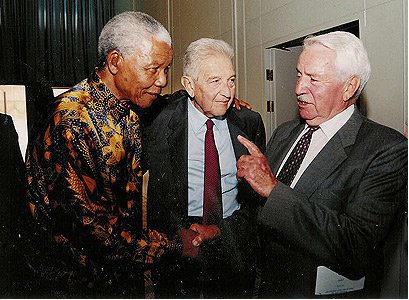
Syd Cohen (right) accompanies the then President of Israel, Ezer Weizman (center),
as his personal physician to the inauguration of South African President, Nelson Mandela (left) in 1994.
An anecdote from World Machal Chairman Smoky Simon, (Chief of Air Operations during the War of Independence) relating to Syd Cohen’s departure from Israel:
Towards the end of March 1949, Dr. Chaim Weizman, first President of the State of Israel, was due to leave on a formal visit to the President of the U.S.A. Shortly before this date, Sydney Cohen had handed over command of 101 Fighter Squadron to the late Ezer Weizman. I phoned Ezer to tell him about this important state visit of President Weizman (Ezer’s uncle) to the U.S.A., and I suggested that as a mark of respect to the President, we should honour him with a two-Spitfire fighter escort out of Israel. Ezer replied that he simply couldn’t afford to set two aircraft aside for this purpose, as his pilot-training program was running late; his aircraft were over-worked and badly short of engine-hours; and he also had a load of maintenance problems, and so on. However, in mid-April when Syd Cohen was flying back to South Africa as a passenger in a Dakota aircraft in order to resume his medical studies, lo-and-behold four Spitfires put on an aerobatic performance as they escorted the Dakota out of Israel. When I asked Ezer to explain this asymmetry in according honors to the President of Israel and to Syd Cohen, he simply replied, “Smoky, do you really think that Syd Cohen would leave Israel without a fighter escort?”
Researcher Joe Woolf’s comments:
As an infantryman, mostly isolated in the North, I had known that there were South African airmen in the Air Force, but had no idea the extent of their contribution.
I was on the same April 1949 flight returning to South Africa with Syd Cohen. Until the appearance of four Spitfires as a farewell escort I did not know Syd’s name or the extent of his importance.
Our first night stop was at Juba, Sudan. Similar to the American Leo Nomis who was ordered to have a drink when they first met in the western desert in 1941, I had wandered into the bar of the hotel with some of the guys I knew who were on the flight, and Syd Cohen was there with the aircraft’s crew. Before we knew it, Syd had thrust glasses of whisky and soda into our hands.
Afterwards our paths never crossed until the World Machal reunions here in Israel. At one of our meetings in Israel, this is one of the gems Syd told me: “You know,” he said, “we fighter pilots knew very little about navigation; to find out where we were, we would simply come down to ground level and read the signs on the railways stations.”
He had obviously read the 1988 edition of Henry Katzew’s “South Africa’s 800” as he disclosed to me, “Now I know what you guys on the ground had done.”
Someone told me the following story: During World War II, Syd was flying wingman above his flight and was attacked by German Messerschmitts. The report that came over the radio was, “How the hell did the Germans know I was the only Jewboy in the squadron?” To those who know Syd, that could easily be believed.
Sources: (i) Leo Nomis and Brian Cull 1998
(ii) Gordon Levett’s “Flying Under Two Flags” 1994, and “Goy Shel Shabbat”
(iii) South Africa’s 800 by Henry Katzew
